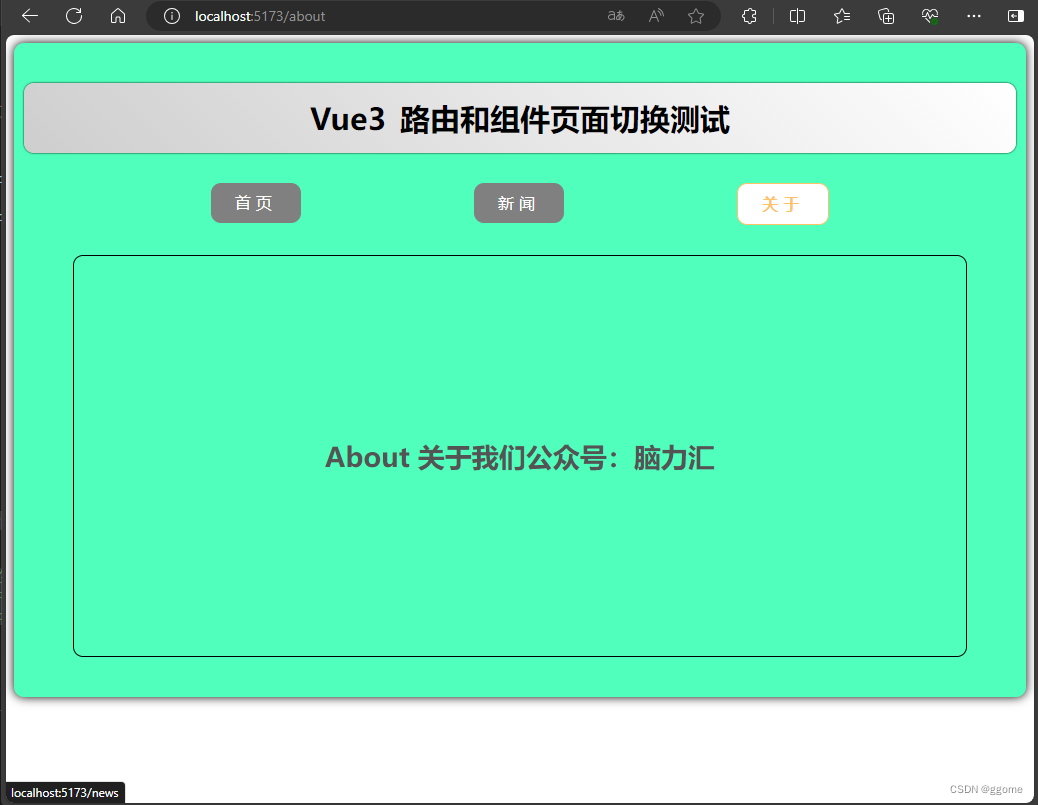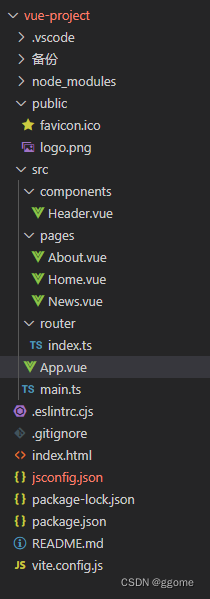Vue3【二十一】Vue 路由模式(createWebHashHistory /createWebHistory )和RouterLink写法
Vue3【二十一】Vue 路由模式和普通组件目录结构
createWebHistory history模式:url不带#号,需要后端做url适配 适合销售项目 利于seo
createWebHashHistory Hash模式:url 带#号,不需要url适配,比较适合后端项目 不利于seo
路由命名 和 配置路由规则
Header 组件是一般组件一般放到components文件夹中
News About Home 组件是路由组件,一般存放在pages或views文件夹中
/*注意
1、路由逐渐通常存放在pages或views文件夹,一般组件通常存放在components文件夹中
2、通过点击路由链接,切换路由组件,视觉上‘消失’了的路由组件,默认是被 卸载 掉的,需要的时候再去挂载
3、路由组件切换时,会触发组件的beforeRouteEnter、beforeRouteUpdate、>beforeRouteLeave钩子函数
实例截图

目录结构

代码
app.vue
<template><div class="app"><Header></Header><!-- 导航区 --><div class="navigate"><RouterLink to="/home" active-class="active"> 首页 </RouterLink><!-- <RouterLink to="/news" active-class="active"> 新闻 </RouterLink> --><!-- to的对象写法 --><!-- 名称跳转 --> <RouterLink :to="{name:'xinwen'}" active-class="active"> 新闻 </RouterLink><!-- 路径跳转 --><RouterLink :to="{path:'/about'}" active-class="active"> 关于 </RouterLink></div><!-- 展示区 --><div class="main-content"><RouterView /></div></div>
</template><script lang="ts" setup name="App">
// npm install vue-router //安装路由器import { RouterView } from 'vue-router';
import Header from '@/components/Header.vue';
// Header 组件是一般组件一般放到components文件夹中
// News About Home 组件是路由组件,一般存放在pages或views文件夹中/*注意
1、路由逐渐通常存放在pages或views文件夹,一般组件通常存放在components文件夹中
2、通过点击路由链接,切换路由组件,视觉上‘消失’了的路由组件,默认是被 卸载 掉的,需要的时候再去挂载
3、路由组件切换时,会触发组件的beforeRouteEnter、beforeRouteUpdate、beforeRouteLeave钩子函数*/</script><style scoped>
.app {background-color: #4fffbb;box-shadow: 0 0 10px;border-radius: 10px;padding: 10px;
}
.navigate {display: flex;justify-content: space-around;margin: 0 100px;
}
.navigate a {display: block;text-align: center;width: 90px;height: 40px;line-height: 40px;border-radius: 10px;background-color: #818080;text-decoration: none;color: #fff;/* font-size: 5px; */letter-spacing: 5px;
}
.navigate a.active {color: #ffc268;background-color: #fff;border: 1px solid #ffc268;font-weight: 900;/* text-shadow: 0 0 1px black; */font-family: 微软雅黑;
}.main-content {margin: 0 auto;margin-top: 30px;margin-bottom: 30px;border-radius: 10px;width: 90%;height:400px;border: 1px solid;
}
</style>
Header.vue
<template><h2 class="title">Vue3 路由和组件页面切换测试</h2>
</template><script setup lang="ts" name="Header"></script><style scoped>.title{text-align: center;word-spacing: 5px;margin: 30px 0;height: 70px;line-height: 70px;background-image: linear-gradient(45deg, #cecece, #fff);border-radius: 10px;box-shadow: 0 0 2px;font-size: 30px
}
</style>
index.ts
// 创建一个路由器,并暴漏出去// 第一步:引入createRouter
import { createRouter, createWebHashHistory, createWebHistory } from 'vue-router'
// 引入各种组件
import Home from '@/pages/Home.vue'
import About from '@/pages/About.vue'
import News from '@/pages/News.vue'
// 第二步:创建路由器
const router = createRouter({// 配置路由模式 // createWebHistory history模式:url不带#号,需要后端做url适配 适合销售项目 利于seo// createWebHashHistory Hash模式:url 带#号,不需要url适配,比较适合后端项目 不利于seohistory: createWebHistory(),// 配置路由规则routes: [// { path: '/', redirect: '/home' },// { path: '/home', component: Home },// { path: '/about', component: About },// { path: '/news', component: News }// 路由命名{ path: '/', redirect: '/home' },{ path: '/home', name: 'zhuye', component: Home },{ path: '/about', name: 'guanyu', component: About },{ path: '/news', name: 'xinwen', component: News }]
})// 第三步:导出路由器
export default router
home.vue
<template><div class="home"><img src="/public/logo.png" alt=""></div>
</template><script setup lang="ts" name="Home"></script><style scoped>
.home {display: flex;justify-content: center;align-items: center;height: 100%;
}
img {width: 10%;
}
</style>

)
![[DDR4] DDR4 相对 DDR3差异与优势](http://pic.xiahunao.cn/[DDR4] DDR4 相对 DDR3差异与优势)






--PN结)
)








